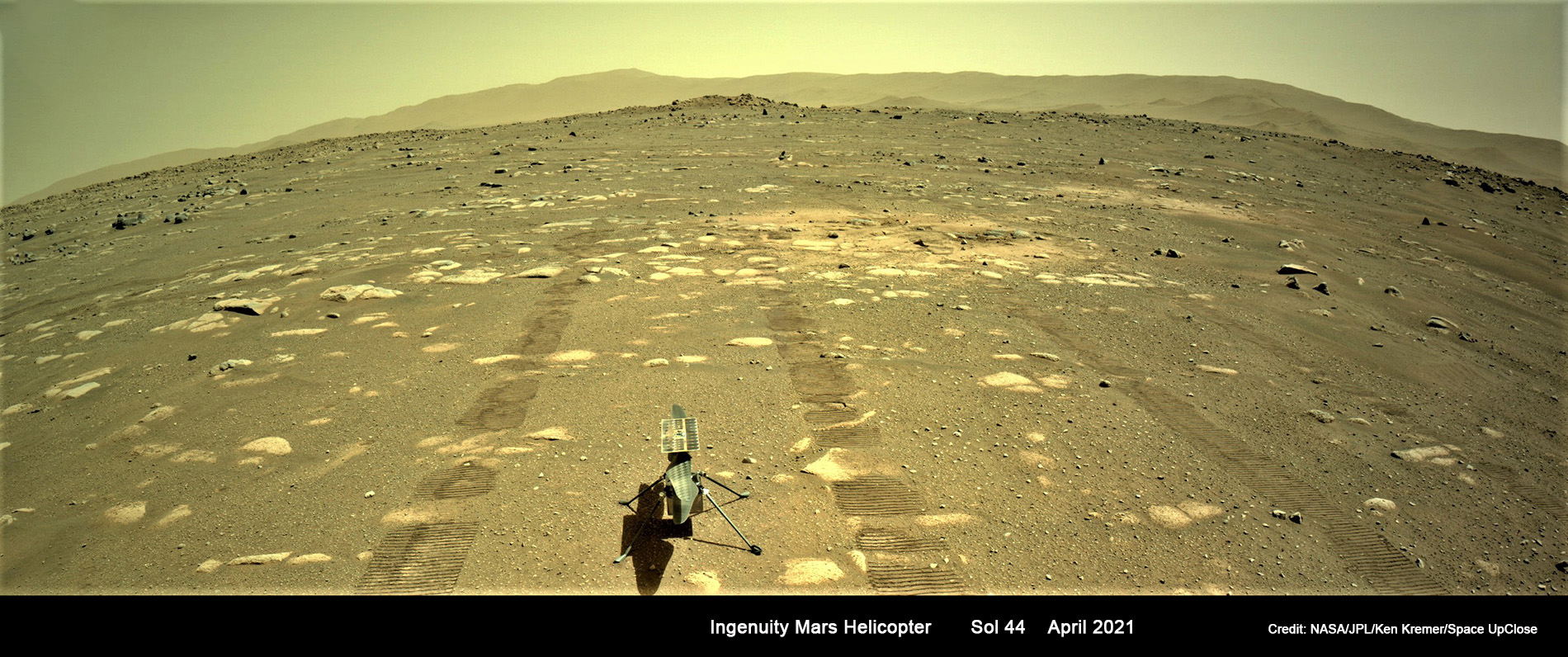
For SpaceUpClose.com & RocketSTEM
CAPE CANAVERAL, FL – NASA’s experimental solar powered Ingenuity Mars Helicopter has safely survived its first frigid night standing alone and all on its own power overnight on Monday, April 5, Sol 44, after being safely deployed to the ‘Martian Flight Field’ on Sunday, April 4, and carefully dropped from the attach point on the belly of the Perseverance rover where its been hanging this past week after completing the methodical step by step unfolding, swing down and deployment of all four graphite composite landing legs
“Making it through the frigid Martian temperatures after being deployed by NASA’s Perseverance rover is a major milestone for the small rotorcraft,” NASA officials confirmed Monday.
“NASA’s Ingenuity Mars Helicopter has emerged from its first night on the surface of Mars.”
“In the days to come, Ingenuity will be the first aircraft to attempt powered, controlled flight on another planet.”
For the first time in history an aircraft from Earth rests on the soil of the Red Planet – and it endured the bitter night to live on! And that’s a truly magnificent thought to behold!
To continue operating the copter must now survive utterly harsh and frigid Martian nights where overnight temperatures at Jezero Crater plunge down to Antarctica-like temperatures of -130ºF (-90ºC).
“Safe & sound on the surface of Mars: the #MarsHelicopter, Ingenuity, has survived the first cold night on its own, a major milestone for the small rotorcraft because surface temps can plunge as low as -130 degrees F (-90 degrees C), ” NASA JPL tweeted.
Safe & sound on the surface of Mars: the #MarsHelicopter, Ingenuity, has survived the first cold night on its own, a major milestone for the small rotorcraft because surface temps can plunge as low as -130 degrees F (-90 degrees C). https://t.co/IqrL757Peg pic.twitter.com/MkSe1UNLKG
— NASA JPL (@NASAJPL) April 5, 2021
“This is the first time that Ingenuity has been on its own on the surface of Mars,” said MiMi Aung, Ingenuity project manager at NASA’s Jet Propulsion Laboratory in Southern California, in a statement.
“But we now have confirmation that we have the right insulation, the right heaters, and enough energy in its battery to survive the cold night, which is a big win for the team. We’re excited to continue to prepare Ingenuity for its first flight test.”
But first the team needs to continue testing and checkouts this week and release of the rotor blades, a key milestone set for April 7.
Before cutting the power and communications cord from the rovers’s belly the team had to ensure that Ingenuity was operating perfectly, and all charged up with its solar panels.
The goal is to conduct a history making ‘Wright Brothers’ first flight moment with the agencies experimental craft on Mars no earlier than April 11 – aiming to make the first attempt at powered, controlled flight of an aircraft on another planet.
Data and imagery will be received back on Earth the next day, April 12.
And Ginny has to do all that in the ultra-thin Martian atmosphere less than 1% as dense as Earth’s.
The $80 million rotorcraft is standing safely upright after being dropped the last 4 inches (10 cm), the NASA JPL team reported on Easter Sunday, April 4, after confirmation was received via the imagery taken on Sol 43 and received back on Earth to the delight of everyone involved in the mission and fans worldwide.
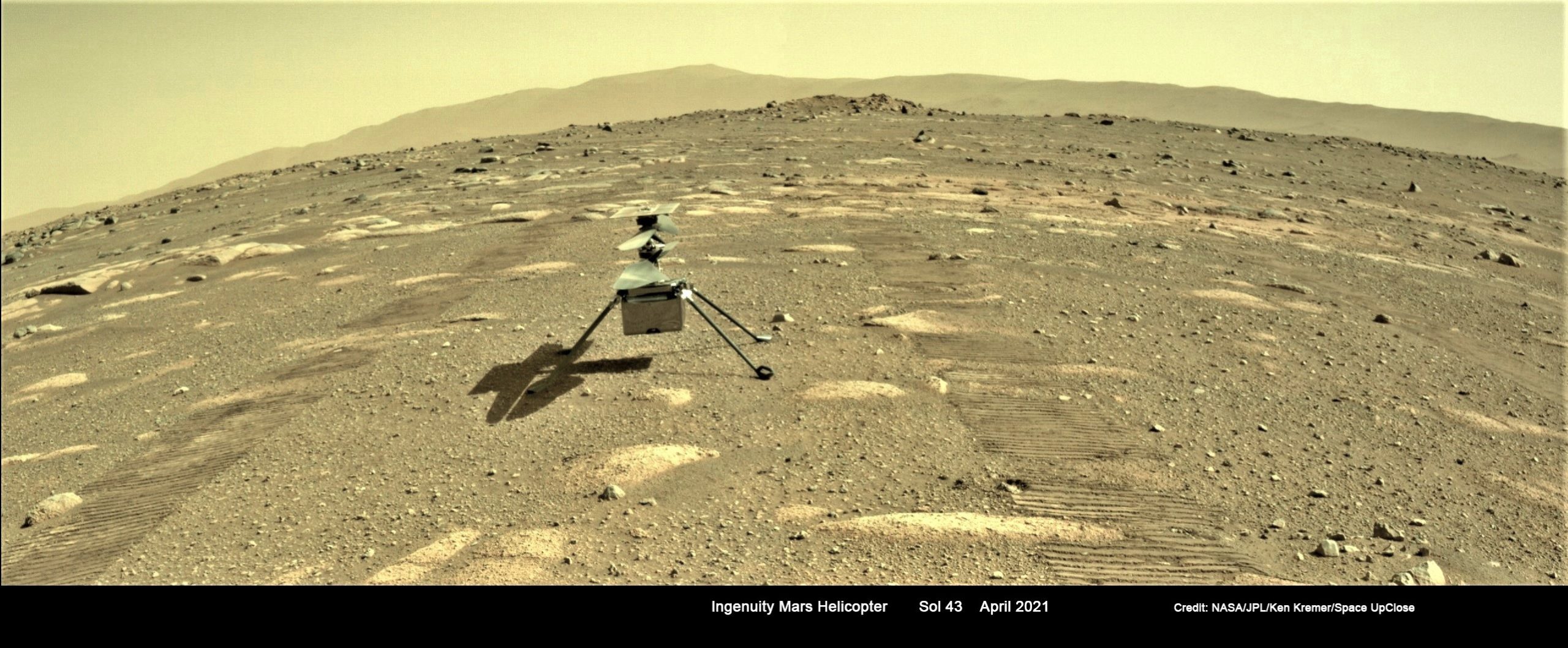
Ingenuity is now completely on its own – left to its own devices and totally dependent on collecting life giving solar energy from the solar array mounted on top of the tiny 1.6 feet or 19 inches (0.49 meters) tall craft to survive the extremely cold Martian night.
After the drop the team had only 25 hours to complete the check outs and charge the six lithium-ion batteries and drive away 5 meters so that Ingenuity could start charging the battery with solar power before Red Planet nightfall at Jezero Crater
New telemetry as well as new imagery from the mast mounted navcam was received Monday, April 5 confirmed Ingenuity had survived the bitterly cold Red Planet night.
A new view of Ingenuity, nicknamed ‘Ginny’ is seen in my Sol 44 mosaic of the new Sol 44 imagery and stitched from two navcam color raw images taken by the mast mounted Perseverance navcam camera to show an elevated and different perspective of Ingenuity on Mars – and shown as lead image above/below.

The two counter rotating blades and solar panel are easily visible in the post-drop imagery.
Ingenuity also took its own first color wide angle image on April 3 while looking down to the surface after being deployed and while still below the rover at the drop point.
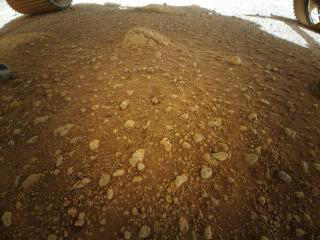
Perseverance serves as the communications relay between Ingenuity and Earth, and it will use its suite of cameras to observe the flight characteristics of the solar-powered helicopter from “Van Zyl Overlook” – from a safe distance some 60 meters away.
The science and engineering team now needs the rest of this week to complete testing and checkouts of the delightfully diminutive 4 pound (1.8 kg) Ingenuity copter, now poised atop the Red Planet at the ‘airfield‘ at the Jezero Crater landing site where Perseverance safely and softly touched down on Feb. 18, 2021 after a seven month interplanetary voyage from Earth.
The next step on April 7, is to release the restraints that have been holding the rotor blades together since before launch.
“If the mission team meets that milestone, the next several sols will involve more testing of the rotor blades as well as the motors that drive them. There are also checkouts of the inertial measurement unit (an electronic device that measures a body’s orientation and angular rate) and onboard computers tasked with autonomously flying the helicopter. Additionally, the team will continue to monitor the helicopter’s energy performance, including assessment of solar-array power and state of charge of the craft’s six lithium ion batteries,” said the team in an update.
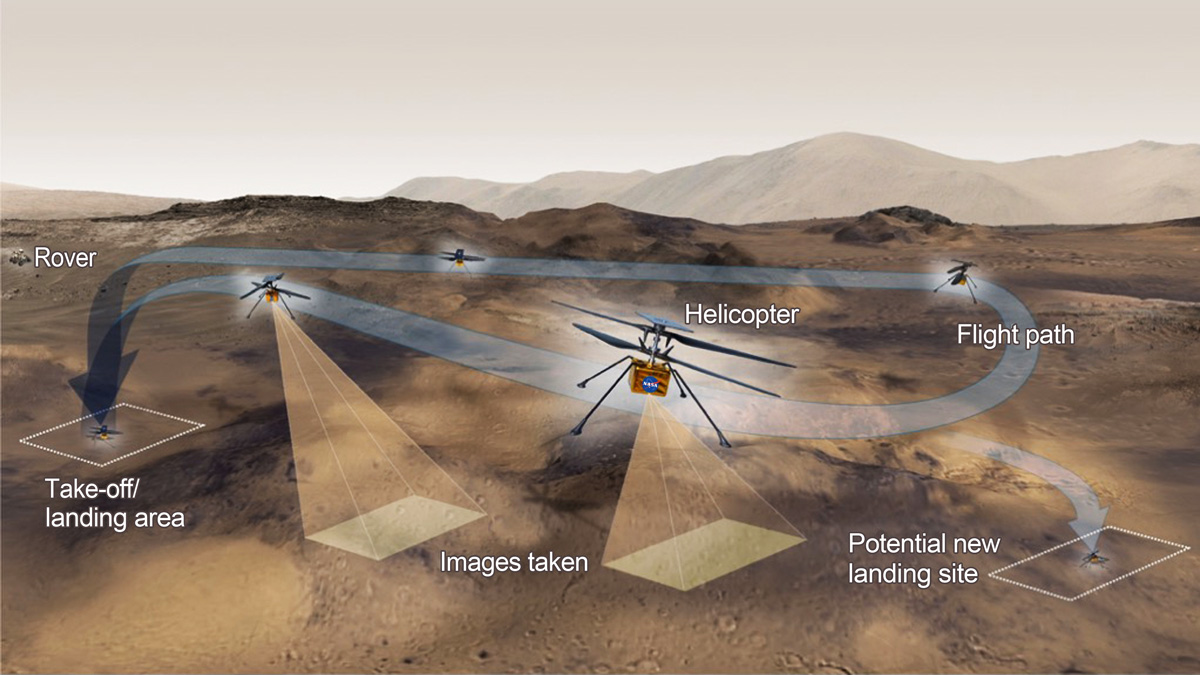
The Ingenuity Mars Helicopter is a technology demonstration experiment aboard Perseverance.
Ginny is not part of the science mission focused on astrobiology and the search for signs of past life on the Red Planet.
Ingenuity is the first Helicopter to ride to Mars and the first to be touched by Martian air.
Since launching in 2020 and since landing on Mars it was stowed on the belly and received its charge from the rover’s nuclear power supply – until dropped on April 4.
With Ingenuity now deployed on Mars’ surface its six lithium ion batteries will be charged solely by the helicopter’s own solar panel.
My commentary about the search for life on Mars and the deployment of the Ingenuity Helicopter was featured in a live interview on March 30 on News Nation Cable TV News Network on ‘The Donlon Report’ illustrated with my Mars mosaics
https://twitter.com/TheDonlonReport/status/1377282034775769092
The solar powered Ingenuity helicopter is a technology demonstration experiment aimed at attempting the first flight on Mars.
The four legged Ingenuity has a mass of about 4.0 pounds (1.8 kilograms) and stands 1.6 feet or 19 inches (0.49 meters) high.
Meanwhile Perseverance has been busy gathering high resolution imagery of her breathtaking surroundings nearby and off into the distance to the stunning walls of Jezero Crater some 2 miles (3 km) away.

Check out the spectacular Jezero Crater scenery in my new mosaics of images taken by the robots mast mounted zoomable Mastcam-Z camera on Sols 36 and 38 – see above/below.

Watch our live and complete ‘Stay Curious’ with live Perseverance landing commentary Feb 18, 2021 as well as March 22 mission update and earlier programs on Mars Mania on Feb 12.
https://www.facebook.com/175507880819/videos/2694057200904814
https://www.facebook.com/175507880819/videos/752176242375043
https://www.facebook.com/175507880819/videos/3246699658764085
Watch Ken’s continuing reports about Mars 2020 Perseverance and Curiosity rovers, Artemis and NASA missions, SpaceX, Starlink, Commercial Crew and Starliner and Crew Dragon and onsite for live reporting of upcoming and recent SpaceX and ULA launches including Crew 1 & 2, Demo-2, ISS, X-37B, Solar Orbiter, NRO spysats and national security missions and more at the Kennedy Space Center and Cape Canaveral Space Force Station.
Stay tuned here for Ken’s continuing Earth and Planetary science and human spaceflight news: www.kenkremer.com –www.spaceupclose.com – twitter @ken_kremer – email: ken at kenkremer.com
Dr. Kremer is a research scientist and journalist based in the KSC area, active in outreach and interviewed regularly on TV and radio about space topics.
………….
Ken’s photos are for sale and he is available for lectures and outreach events
Ken has created hundreds of widely published Mars rover mosaics and lectures also about NASA’s Mars rovers
Please consider supporting Ken’s work by donating at Patreon:
https://www.patreon.com/kenkremer
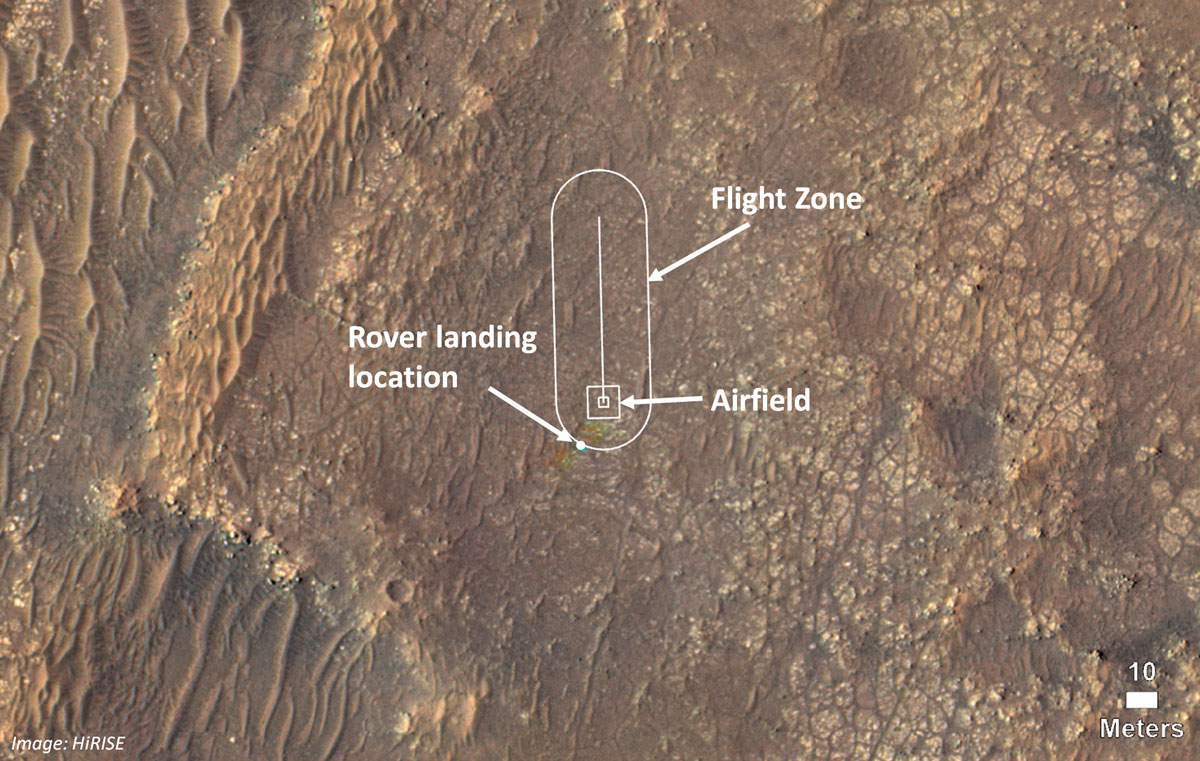
Some small rainbow-like color distortions (which do not actually appear on the terrain of Mars) are seen in this image near the landing location because of the way pre- and post-landing color images were merged. Credit: NASA/JPL
x



